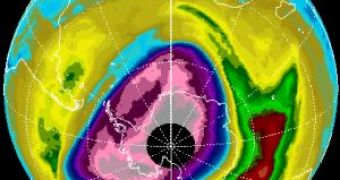A new study - made by the US government and based on more than 40 years of monitoring the ozone from polar observation stations and balloon-borne measuring devices - compares the severity of the ozone loss in the Antarctic compared to the same phenomenon in the Arctic over the past 20 years.
The results show "massive" and "widespread" localized ozone depletion in the heart of Antartica's ozone hole region, beginning in the late 1970s, but becoming increasingly big in the 1980s and 90s.
The study noticed that there was an almost complete lack of ozone in certain atmospheric air samples taken after 1980, compared to earlier periods. In contrast, the ozone losses in the Arctic were sporadic, and even the greatest losses did not begin to approach a regular pattern in the northern hemisphere. "Typically the Arctic loss is dramatically less than the Antarctic loss," said Robert Portmann, an atmospheric scientist with the National Oceanic and Atmospheric Administration in Boulder, Colorado.
In October 2006, NASA researchers reported that this year's hole is the biggest ever, stretching over nearly 11 million square miles (28 million square kilometers).
In Antarctica, local ozone depletion at some altitudes often passed 90 %, reaching up to 99 % during the Antarctic winter in the period after 1980 compared to earlier periods. In the Arctic, the situation is very different: the losses occasionally peaked at 70 %, and some losses of 50 % were seen in the mid 1990s, when temperatures were particularly low, but the span of the phenomenon was much more reduced in the Northern Hemisphere.
Recent research has also pointed to large ozone losses in the Southern Hemisphere, but the NOAA researchers said their study showed that these events were rare and did not appear to signal a trend. "We saw small to moderate ozone losses in the very coldest winters, when the stratospheric conditions are ripe for ozone loss, but they were rarer than we expected," said Portmann.

 14 DAY TRIAL //
14 DAY TRIAL //